Lea Wait's Blog, page 71
February 3, 2023
Weekend Update: February 4-5, 2023
 Next week at Maine Crime Writers there will be posts by Brenda Buchanan (Monday), Jule Selbo (Tuesday), Joe Souza (Thursday), and John Clark (Friday).
Next week at Maine Crime Writers there will be posts by Brenda Buchanan (Monday), Jule Selbo (Tuesday), Joe Souza (Thursday), and John Clark (Friday).
In the news department, here’s what’s happening with some of us who blog regularly at Maine Crime Writers:
Matt Cost has had the second book in the Clay Wolfe Trap series, Mind Trap, be released on audiobook through Audible. This follows last month’s release of Wolfe Trap. The second book in his Mainely Mystery series, Mainely Fear, will release on audible February 15th. Cost also did an interview with Big Blend Radio that will air on April 12th, the release date of his his debut Brooklyn 8 Ballo mystery, Velma Gone Awry. He has also had a request, and written, an article for Writer’s Digest on how an author decides who lives and who dies in their novels, To Kill or to Let Live.
Kate Flora: An important question for our readers. In the past few years, spring has brought our “Where Would You Put The Body” contest. Although the photos submitted have been great, and greatly entertaining, we’ve hoped for more entrants. So we are asking you: Should we run the contest again this year?
An invitation to readers of this blog: Do you have news relating to Maine, Crime, or Writing? We’d love to hear from you. Just comment below to share.
And a reminder: If your library, school, or organization is looking for a speaker, we are often available to talk about the writing process, research, where we get our ideas, and other mysteries of the business, along with the very popular “Making a Mystery” with audience participation, and “Casting Call: How We Staff Our Mysteries.” We also do programs on Zoom. Contact Kate Flora
Slippery Winter Roads? Drive like You Have a Dozen Eggs on the Seat
Kate Flora: The weatherman says we should expect severe cold by the weekend. Farther
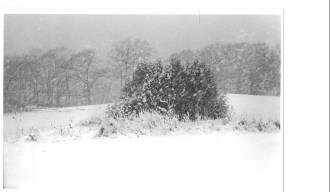
From Sennebec Hill in a snowstorm
north, there will likely be snow. I am settled into my now daily wardrobe of fleece-lined leggings and a heavy fleece top. Not figure-flattering but when the weather is this cold, I’m not planning on venturing out. My husband doesn’t notice and my plants don’t care. So as I settled in at my desk, scrolling through old posts for today’s inspiration, a copy of mom’s first book, From the Orange Mailbox, tumbled off my over-crowded desk. I started thumbing through it and decided that today what we all need is a dose of country living and old-timers storytelling from A. Carman Clark.
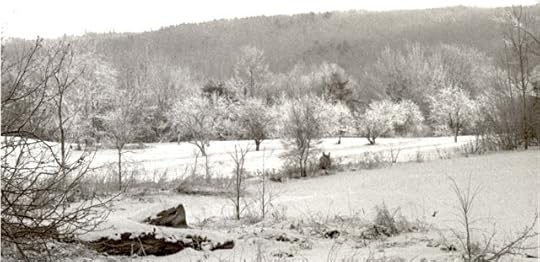
The apple orchard in winter.
The old-timers brought forth their stories about blizzards in this valley each time anyone “from away” complained about the winter storms. They told about tunneling through drifts to get to the barn and how in years past piles of snow were still snug against the north sides of buildings on May Day.
One year, I was told, the drifts in front of my farmhouse were so high that the men plowed out (or was it rolled down?) a detour around behind the barn and up through the blueberry field. They didn’t find East Sennebec Road again until April.
Driving through these winter storms leaves me feeling as though I’ve just been given three blood transfusions. No matter which route I take, I can’t get out of town and back home without facing at least one big hill. If there’s a storm, there are cars slithered crosswise halfway up or down those hills. I find myself talking to my car the way my grandmother used to talk to her horse, coaxing her on, praising her steadiness, and shouting encouragement as we gently skirt the stalled vehicles and climb on up the hill.
The first–and best–advice given to me about winter driving was offered by an old-timer who rescued me about a month after I got my first driver’s license. My multiple attempts to get up over Town House Hill (the only direct way out of the village in those days) were observed with interest by the men socializing in the local garage.
Finally I went into the garage to ask when the sanding truck might be along. No one knew but they did express the opinion that with good driving that hill was not a hazard. I wasn’t about to put on another backsliding exhibition. I stood quietly thinking very evil thoughts until at last one of the old-timers allowed as how it would be neighborly if he got my car up the hill for me.
After he had backed down four times (aware of the audience) he volunteered to drive me home in his car by the alternate route up the other side of the river. Enroute he gave me advice about driving in Maine winters.
“Now, comes weather like this you just make believe you got a dozen eggs right there on the seat beside you and you drive so they don’t fall off.”
“I wasn’t driving carelessly,” I protested, “and a box of eggs…”
“Lady,” my instructor said gently, “them eggs ain’t in no box.”
Many dozens of imaginary eggs have ridden beside me through stormy winters. Advice worth remembering.
But if I don’t have to venture forth, I like blizzards. I think of them as a warp in time–a period of unallotted hours. Freedom from musts and should and any kinds of chores. Usually I mix some bread dough because I enjoy the kneading and the aroma of baking loaves. I read, take naps, dig out some old 78 records, thaw some strawberries and asparagus–just let go and enjoy my own company.
Blizzard days were a pleasure when the children were in school because all took a bit of that “this day is a gift” attitude. From the upstairs bedroom we would drag down the Blizzard Box which contains years of recipes clipped from newspapers and magazines.
First we’d rummage through, taking and thinking about something different to eat. Then we’d set a few aside to try someday. Eventually we’d find a few too good to miss and start cooking. Many of our family favorites (preserved in the Good Book of Tested Recipes) were discovered and tried out during raging northeast storms. The box went back looking as full as ever but it was a delightful way to spend a few housebound hours.
Most of the old-times who told of blizzards past are no longer around–but their tales remain part of the legends of this valley. Perhaps their storms really were worse or longer. Or it may be that they settled in and enjoyed them and wove yarns to pass along to newcomers in Georges Valley.
When a blizzard can be–like a vacation–a suspension of regular activities in order to rest and refresh one’s mind and body, it adds a lift to the weeks of winter.

The world famous Orange Mailbox on East Sennebec Road.
February 1, 2023
Making it Better
Kathy Lynn Emerson/Kaitlyn Dunnett here, today as Kathy. As I’ve mentioned before, I’ve been doing a complete rewrite of one of my earliest published books, Winter Tapestry (1991), switching from multiple points of view to just one and emphasizing the murder mystery over the elements of romance and espionage. No scene has been left unchanged, although obviously some things stayed the same.
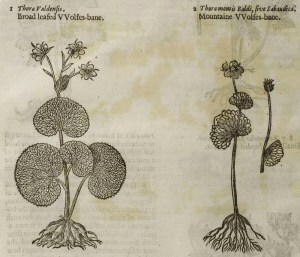
Wolfsbane, the poison used to murder Cordell’s father
Since readers of this blog may be interested in the process, I’ve decided to share a sample of what I’m doing to improve on the original. This is a brief scene in which Cordell, the protagonist, makes her escape from the free city of Strasbourg, where she and her father joined other English exiles after Mary Tudor became queen. I won’t get into all the ins and outs of the historical background. Suffice it to say that it’s 1553/4 and plots, counterplots, and spies abound. Cordell’s father has been murdered, possibly by the very person in whose house they’ve been living (Matthew Wood in the original; now renamed Francis Roydon). She is desperate to return to England and also to escape being married off to Roger Allington, a young man she fears may be in league with the conspirators. The arrival of her father’s steward (Tom in the original and Simon in the new version) gives her a way out.
Here’s the Winter Tapestry version from a little over a third of the way through a 90,000 word book:
As soon as Cordell came down the household left for the wedding. She hung back as much as she dared, but it was not until the doors of the church gaped wide in front of them that Cordell and Tom were out of sight of the others. Staring into the dark interior, Cordell knew a moment of blind panic, a failing of her trust. If Tom had changed his mind . . .
But Tom, as soon as the back of Mistress Ponet’s rustling skirts disappeared completely within, caught Cordell’s elbow and propelled her rapidly back down the stone steps and into the street. They ran together, heedless of curious stares, into a dark alley, then out onto another narrow lane. Tom’s two horses were tethered and waiting for them.
Breathless, Cordell kilted up her skirts and mounted, not caring what any thought of the display of leg. She was doing it. She was getting away. She barely felt the hard little saddle slamming into her seat, or the rough stirrups rubbing against her wool stockings. She dug her heels into the horse’s flanks to urge him to greater speed. Moving as quickly as they dared through the twisting, cobbled streets of Strasbourg, they fled toward the riverbank.
“I’ve a barge waiting,” Tom called over his shoulder. “We’ll head south in case any think to follow. They’ll not expect that.”
Cordell laughed aloud. It was appropriate, and not without irony, that they should head in the wrong direction. Everything seemed turned around since Sir Anthony’s death, so much so that she wondered if it would ever be right again.
They boarded without challenge and as the watercraft slipped away from shore, Cordell looked for the last time upon Strasbourg. Was justice slipping away, too? She knew there was no more she could do to gather evidence if she stayed, that her continued presence only endangered the success of her father’s mission, and yet she felt uneasy, as if she had missed something important, some clue so obvious that she’d discounted it.
“I’ll see to the horses,” Tom said, giving her elbow an encouraging squeeze before he left.
Dear Tom, she thought as she watched him move away. She was taking advantage of his loyalty shamefully, even shamelessly. Her smile turned wry. She could imagine what they were saying back at the church. She wondered, too, if they had really meant to let her leave with Roger. It depended, she supposed, upon how deeply involved he was in their treasonous plans. It scarcely mattered now. Tom had freed her from all of them.
But even as the thought passed through her mind, she saw the arm uplifted in the water below. A swimmer was approaching the barge, and when his head lifted, briefly, above the river’s surface, she had to stifle a cry of dismay.
His strength was failing. She sensed it even as she realized no one else had seen the lone figure following them. She could turn away, and be safe, but if she did, Martin would surely drown. With an anguished sound, she flung herself flat at the edge of the splinter‑laden wooden surface and stretched out her hands. Seconds later she had his wrists in her grasp. Another moment and he was scrambling up beside her, dripping like a drowned rat and smelling worse, and offering her a hand to help her back to her feet.
“I will not go back, Martin,” she told him firmly.
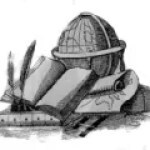
And here’s the current version, about a third of the way through a 73,000 word manuscript:
A short time later, the Roydons and the Ponets left for the small stone church the English exiles shared with a French‑speaking Calvinist congregation. Roger had already gone ahead. They would expect the bride, since she had convinced them she was resigned to the marriage, to set out in that direction a few minutes later, escorted by Simon Fuller. Instead, Simon and Cordell turned the opposite way, heading for the narrow lane where Simon had tethered two horses.
As soon as they were out of sight of Roydon’s house, Cordell ripped the garland from her hair and tossed it away.
Uncaring that she displayed her legs to the curious stares of passers-by, Cordell kilted up her skirts and mounted a placid bay mare. Taking only time enough to pull the hood of her cloak up over her head, she dug her heels into her mount’s flanks and followed Simon’s larger horse, a dappled gelding, to ride as fast as they dared through the twisting, cobbled streets of Strasbourg toward the river.
Their destination was a passenger barge bound for the quiet Alsatian town of Colmar. Once aboard, Simon left her standing near several large bales of trade goods while he saw to securing the horses.
Dear Simon, she thought as she watched him move away. He had not hesitated to help her escape and she knew she could count on him to keep her safe on the long journey ahead.
By now everyone waiting at the church would know she and Simon had disappeared. They would search for them, she supposed, but by the time they thought to visit the waterfront, the barge would be long gone. That thought had no sooner passed through her mind than she caught sight of a familiar face.
Just as the barge began to move away from the dock, a gangly figure launched itself toward the deck. For a moment, Cordell thought he would end up in the river and likely drown, but by some miracle he succeeded in making the jump. He was breathing hard when he trotted up to her but his face wore a triumphant grin.
“I will not go back, Martin.”

Not so different, you say? Well, no. Is it better written? I think so. And there was a good reason for having Martin make the leap to the barge instead of swimming after it. Following the publication of Winter Tapestry, someone who had actually been to Strasbourg informed me that any attempt at such a feat would have been fatal. Poor Martin would have drowned.
Scenes Cordell wasn’t in are gone, of course, although some of the information in them had to be presented elsewhere (clues, you know!). I’ve also added to some scenes, fleshing out secondary characters and adding dialogue and descriptive details. I switched the order of paragraphs around in a great many places, since the original order didn’t always make sense. In real life, jumping from subject to subject and back again during a conversation isn’t unusual, but in written dialogue it can be confusing.
I’m sure there will be those who think I’ve been wasting my time rewriting a perfectly good book, especially one that I already reissued as an e-book back in 2003. But aside from the fact that some of the clunky sentences in the old version literally made me cringe, there’s been another benefit for me in tackling this project. I’m enjoying writing again. I’m actually having fun making it better.

cover of the currently available e-book
Kathy Lynn Emerson/Kaitlyn Dunnett has had sixty-four books traditionally published and has self published others, including several children’s books. She won the Agatha Award and was an Anthony and Macavity finalist for best mystery nonfiction of 2008 for How to Write Killer Historical Mysteries and was an Agatha Award finalist in 2015 in the best mystery short story category. She was the Malice Domestic Guest of Honor in 2014. Her most recent publications are The Valentine Veilleux Mysteries (a collection of three short stories and a novella, written as Kaitlyn) and I Kill People for a Living: A Collection of Essays by a Writer of Cozy Mysteries (written as Kathy). She maintains websites at www.KaitlynDunnett.com and www.KathyLynnEmerson.com.
January 31, 2023
Writing Advice from the Trenches
 In our MCW group post this month we will be sharing a piece of writing advice that we have found helpful. Or a piece of advice that we’ve learned from experience. Or a piece of advice from a favorite writing book. We hope you enjoy these and will find one that resonates with you.
In our MCW group post this month we will be sharing a piece of writing advice that we have found helpful. Or a piece of advice that we’ve learned from experience. Or a piece of advice from a favorite writing book. We hope you enjoy these and will find one that resonates with you.
Kate Flora: I am sure that you have heard this before, but I will say it anyway: write on a regular schedule. Every day, if possible, or on set days. Creating a regular writing practice helps to strengthen your writing muscles. It also, as time passes and the pages pile up, gives you insight into yourself as a writer. Are you a burst writer? A plodder? Do you need an outline to guide you or are you a writer who loves discovering what comes next? Do you prefer to write for a fixed period of time or does it work better for you to have a word count you must reach before you leave your desk? I am sure you have all heard me say, many times, that if you want to finish that book or that short story, you can’t wait for a moment of inspiration or for the fluttery little muse to land on your shoulder. You need to be at the desk, in the chair, and present when the muse arrives.
My other piece of advice, gleaned from ten years in the unpublished writer’s corner, is that despite the discouragement the publishing world can hand out, only YOU get to decide that you are a writer. It’s a great Dumbo’s feather to cling to in difficult times.
Maggie Robinson: I so agree with Kate that you should try to write every day. And I also think that if you can’t, for whatever reason, do not beat yourself up. Life happens. But it’s good to get into some sort of routine. When I worked full-time, I made myself get up at 4 AM to write. I had a quiet house to myself and no interruptions. It helped to have a supportive spouse and family who could find their own socks and make their own breakfast. I have a friend who waited till her kids were asleep and worked into the wee hours, another who brought her laptop with her everywhere so she could write at her kids’ doctor appointments and sports activities. She made every idle moment count, and those ten-minute chunks here and there added up. Find what works best for you, because there’s no universal magic trick to getting to The End! 
Kaitlyn Dunnett/Kathy Lynn Emerson: I have two pieces of advice for writers. The first relates to what writers often call “the book of the heart.” If telling a particular story is important to you, don’t give up. It may not be something that will ever be a commercial success, but these days there are alternate routes to publication. I’m practical enough to encourage writers to aim for contracts with healthy advances and good publisher support, but writing what you want to write matters, too. The second bit of advice is related to the first: it takes as long as it takes. That applies to both writing a book and selling it, and leads right back to the “don’t give up” advice. If writing is your calling, it should be a joy, not a chore. Sure there are frustrations along the way, but there’s nothing better than holding the finished creation in your hands and knowing that, somehow, miraculously, that story got from your mind to the printed page.
John Clark: I’m going to be a heretic and tell you there are times when you should give yourself permission NOT to write. Earlier this month, I realized I had a stronger desire to read some of the pile of books whispering to me, than the call from Bent River. However, I’d also encourage anyone who’s got a blast of words in their head to get them out, especially when you find yourself distracted by them. Definitely not a good idea to be in rush hour traffic while your characters are screaming at you to get that scene on paper.
Matt Cost: Write. Write on.
Sandra Neily: I have this Reasons to Write list on my wall. (I started out in 2016 caring most about 2, 5 and 8. Now, older and wiser about publishing and navigating some medical stuff, I lean toward #1 and # 9.) Knowing this change has been so very helpful; I am more at peace about what I am doing. Maybe the message is that we need to regularly check in with our core motives and desires. They might have evolved.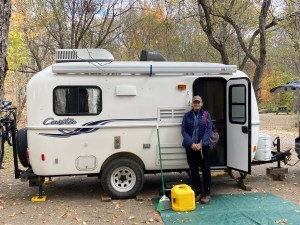
 And no matter what one writes (fiction, nonfiction) a grab-em mission statement you can share in a short elevator ride or social moment is a great thing. Ya never know! It can change too. My latest: I want to take readers on a north woods field trip that is so compelling, engaging, and mysterious that they won’t want off the trip until the last page.
And no matter what one writes (fiction, nonfiction) a grab-em mission statement you can share in a short elevator ride or social moment is a great thing. Ya never know! It can change too. My latest: I want to take readers on a north woods field trip that is so compelling, engaging, and mysterious that they won’t want off the trip until the last page.
Brenda Buchanan: My advice is to find your writing community. If you’re writing crime fiction, hoo-boy, is there a great crime fiction gang here in Maine and a more welcoming group you’ll never find. The same is true whether you write sci-fi, or fantasy, or romance, or young adult.
How to find other writers? Take advantage of the programming at local colleges and universities, join a statewide organization like the Maine Writers and Publishers Alliance, attend conferences and workshops if you can afford it. All are great ways to find your peeps.
If cash is tight, use the internet to look for writing groups in your area. Your local librarian almost certainly knows the other writers in your community, and if you sign up for your local independent bookstore’s mailing list you’ll know about all the upcoming readings and book events.
Most every writer needs to commune with other writers. Making connections—however shy you may feel at first—will get you through the hard times, and give you people to celebrate with when you have reason to celebrate.
Want more writing advice? Scroll back through our posts and you will find a wealth of great advice from writers who have been at this for years.
January 29, 2023
The Road to Maine was Paved with . . . Words
Please welcome our special guest, Kait Carson, to Maine Crime Writers.

Thank you, Maine Crime Writers, for inviting me to blog with you today. I’m an avid reader of this blog. The topics are diverse, and always interesting. I’d also like to thank Maine for its warm welcome. Maine has a reputation of shunning new residents, generally known as “people from away”. My experience has been quite the opposite. Maybe it’s a Valley thing, as in the St. John Valley. In the Crown of Maine, folks are warm and welcoming. Winter, not so much.
In 2005 hubs and I decided to pull up stakes in South Florida and move to northern Maine. The County, to be exact. We’d had it with the heat, and we won’t talk about hurricanes. There was only one problem. I was a Florida probate litigation paralegal. Not much call for that in Fort Kent. Can you see my secret smile? The happy dance in my heart increased with every mile. Torts were about to give way to tomes. In my world, this is known as living the dream.
There is something about Maine that fosters creativity. Whether it’s tales from long-time residents, the long, dark, nights, or the mysterious shadows of the pine forest, inspiration creeps into your soul and bubbles out through your fingertips. Words flow and ideas collide faster than you can capture them. Nirvana for writers.
We weren’t in the Valley a week when new friends took us out to dinner. As the wine flowed, our hostess reached across the table and patted my hand. “Strange stuff happens around here.” She slewed her eyes in the direction of the road to the Allagash. “My late husband worked for the railroad. The stuff that goes on in the woods has no explanation.” She declined to elaborate when her boyfriend gave her the one-eyebrow raised look. Didn’t matter, I soon had my own experiences to mull over.
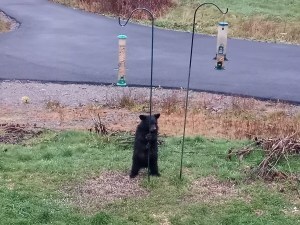
Kait’s pole-dancing bear cub
Daylight comes late in the north woods. One morning I glanced out my office window to see the side of my driveway illuminated by a pillar of light. I reached for my phone to take a photo, but when I looked back, the woods were completely dark. Then there was the night I sat on the porch to catch a meteor shower. As stars flew through the sky, the treetops on the south side the property lit up as if bathed in a spotlight. There was no sound, we’re too far from the road for it to have been reflected truck headlights, and there’s no road behind or to the side of the property. In fact, if you walk out our back door, you can walk one hundred miles straight to the St. Lawrence Seaway and not encounter another human being or habitation except for the remains of abandoned logging camps. Nothing there to cast light on the tops of the trees.
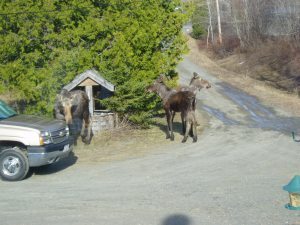
local wildlife
Maine’s mysterious topics continued to provide fertile soil for a myriad of short stories and essays, but I wasn’t ready to expand the setting into longer works. So, when I learned of the National Novel Writing Month (NANOWRMO – NANO for short), I returned to my Florida roots for my first attempt at a novel. Maybe there is something to Hemingway’s “write what you know” exhortation.
I plundered my dive logs for material. After all, what better place to hide a body than under one-hundred and twenty feet of water. One dive, on the wreck of the Thunderbolt, stood out. A flesh-colored plastic bag floated from the wheel house of the long-sunk vessel. I caught sight of it from the corner of my eye and for a brief, shocking, moment, the undulating plastic appeared not as a bag, but a hand. That event provided the infamous inciting incident for Diving Diva. The book morphed into the full-length novel titled Death by Blue Water. The first of the Hayden Kent mysteries recently re-released and now available on Amazon.
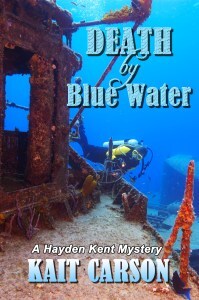
Florida and scuba diving provide the backdrop for two more novels, Death by Sunken Treasure and Death Dive. The dark reaches of the northern Maine woods are set to feature in the Sassy Romano mysteries with the first, Deadly Deception, scheduled for release in the fall of 2023. Sassy inherits her family’s inn and artists retreat from her great aunt. What can possibility go wrong?

Kait Carson writes two series set in the steamy tropical heat of Florida. The Catherine Swope series, set in greater Miami, and the Hayden Kent series set in the Fabulous Florida Keys. A new series, the Maine Lodge mysteries, features Sassy Romano, a newly divorced thirty-something, who puts her past behind her when she inherits her family’s Inn and artist retreat.
Like her protagonists, Kait is an accomplished SCUBA diver, hiker, and critter lover. She lives with her husband, four rescue cats and flock of conures in the Crown of Maine where long, dark, nights give birth to flights of fictional fantasies.
You can reach Kait at kait@kaitcarson.com
January 27, 2023
Weekend Update: January 28-29, 2023
 Next week at Maine Crime Writers there will be posts by special guest Kait Carson (Monday), a group post (Tuesday), Kaitlyn Dunnett/Kathy Lynn Emerson (Thursday), and Kate Flora (Friday).
Next week at Maine Crime Writers there will be posts by special guest Kait Carson (Monday), a group post (Tuesday), Kaitlyn Dunnett/Kathy Lynn Emerson (Thursday), and Kate Flora (Friday).
In the news department, here’s what’s happening with some of us who blog regularly at Maine Crime Writers:
An invitation to readers of this blog: Do you have news relating to Maine, Crime, or Writing? We’d love to hear from you. Just comment below to share.
And a reminder: If your library, school, or organization is looking for a speaker, we are often available to talk about the writing process, research, where we get our ideas, and other mysteries of the business, along with the very popular “Making a Mystery” with audience participation, and “Casting Call: How We Staff Our Mysteries.” We also do programs on Zoom. Contact Kate Flora
The mysterious case of Elizabeth Freel
From time to time, we introduce you to guests whose work we believe you will find as fascinating as we do. Today’s guest is one of them, as you will soon discover.
Kristen Seavey
IntroI spend a lot of time with old newspapers, and I love it. One of my favorite parts of having a true crime podcast is research. My show, Murder, She Told (https://murdershetold.com), which focuses on Maine and New England true crime, uses a lot of these old newspapers in the cases we present.
Digging through archives, I’ll often stumble upon headlines I wasn’t originally looking for—cases that have been buried with time. Some that made their way through the justice system and out of the headlines. Others that didn’t get that far, and, at some point, were given up on.
The case of Elizabeth Freel (https://www.murdershetold.com/episodes/elizabeth-freel) from 1936, whose body was found burning in the mountains of New Hampshire, is by far the most bizarre and baffling historic case I’ve discovered.
“CHARRED AND BROKEN BODY OF WOMAN FOUND ON LONELY MOUNTAIN.”
 Around 4:00PM on the afternoon of May 20th, 1936, firefighters were called to Rattlesnake Hill to put out a fire. Rattlesnake Hill overlooks the Connecticut River Valley and borders Brattleboro, VT. It was given its name because at the time, it was infested with rattlesnakes (yes, rattlesnakes). The men climbed a steep, overgrown 2-mile trail in full gear and spent all night putting out the flames, and by the morning, they had made a gruesome discovery.
Around 4:00PM on the afternoon of May 20th, 1936, firefighters were called to Rattlesnake Hill to put out a fire. Rattlesnake Hill overlooks the Connecticut River Valley and borders Brattleboro, VT. It was given its name because at the time, it was infested with rattlesnakes (yes, rattlesnakes). The men climbed a steep, overgrown 2-mile trail in full gear and spent all night putting out the flames, and by the morning, they had made a gruesome discovery.
The source of the fire wasn’t a bolt of lightning or a smoldering cigarette butt; it was the body of a woman, burned beyond recognition.
At the crime scene, they discovered about a dozen bullets embedded in the dirt under where she lay, a fully loaded .22 caliber revolver, a 1-gallon empty maple syrup can, and 99 cents scattered about. There was blunt force trauma on the back of her head, and both of her arms and legs were broken. A burned-up suitcase lay on top of her remains. They determined that an accelerant had been used to light the fire.
Grace HurleyNothing at the scene had a name of the mystery woman, so they set about trying to figure out who she was.
The police told the media they believed she was a young woman, and the medical examiner said that she had recently had an abortion shortly before death, spurring rumors of a scorned lover taking revenge. Was it murder? Or did she die by suicide?
They were able to use the serial number of the gun to determine where it had been sold. When they contacted the shop owner, he said that the woman had given the name Grace Hurley, and said she was from Boston. He recalled that she was middle-aged, and seemingly wealthy, peeling off twenties from a roll of bills that looked to contain about $500.
Through some more detective work, and through the help of reporters at the Brattleboro Reformer, it was determined that a guest at a local hotel had given the name Grace Hurley, and had signed in on Tuesday, May 19th, just two days before the fire. She, too, gave her hometown as Boston.
Locals remembered her walking on the trails, interacting with other guests, and paying for everything in bills from a large roll of cash. The Great Depression wouldn’t end for another few years, making people who carry and present large wads of cash something memorable for most people.
But none of the Boston officials that the police contacted seemed to know anything about a Grace Hurley. Was Grace even here real name? The police offered up dental records as well as Grace’s signature to the media, hoping somebody would come forward.
Fortunately, Boston papers picked up the story, and a man in Clinton, Massachusetts recognized the handwriting in the paper and the pseudonym, “Grace Hurley.” It was his wife… Elizabeth Freel. He contacted their dentist, and the doctor confirmed it: the records matched. Grace had been unmasked.
So how did Elizabeth end up on that mountain? And why was she using an assumed name?
Elizabeth’s husband, Robert Freel, told detectives their relationship was unusual. In recent years, Elizabeth had been taking off for days or weeks at a time, returning home when the money ran out. He said her wanderlust was connected with a nervous condition that she had suffered from for nearly 15 years. She’d stay at extravagant hotels under pseudonyms in cities like Boston and New York. Grace Hurley was her favorite name. He never asked questions, and always left $50 around the house so she wouldn’t be without money. He said that despite her quirks and her mental health disorder, he didn’t think his wife would take her own life. He also said he knew nothing of her apparent pregnancy or abortion.
Unravelling the mysteryInvestigators discovered that Elizabeth had made two trips to the Brattleboro area before her death. The owner of the hotel she stayed at said she seemed nervous and like she was waiting for somebody. She would take long walks out towards the mountain, which was odd considering she was in heels.
A few days before the fire, on her second and final trip to Brattleboro, she purchased the revolver and the one-gallon maple syrup can. On the morning of her death, Elizabeth herself purchased the flammable cleaning solution—a mixture of gasoline and kerosene—that investigators believed was used to stoke the blaze.
Investigators revisited the crime scene, hoping to find additional clues, and discovered they’d missed a brand-new flashlight in a bush nearby, in a bag with a receipt from a Five and Dime marked the same day as the fire. The clerk remembered a young man buying it, but didn’t know his name. Could he be connected to Elizabeth? Their search for a potential weapon that caused the blunt force trauma was unsuccessful.
Everything that was found at the crime scene was scattered: her dentures were found 12 feet away from her body, the syrup can was 25 feet away, and her suitcase was lying on top of her body.
Police were completely baffled. The circumstances were, and still are, completely mystifying.
Elizabeth climbed a steep, extremely overgrown, rattlesnake infested 2-mile trail with a suitcase and a gallon can full of flammable solution… in heels.
Her body was found off the trail in untamed forest with trauma to the head, broken bones, and completely immolated. The medical examiner believed the broken bones most likely came from the extreme heat of the fire, but the heat didn’t explain the head trauma. How could she do all these things to herself? Why would somebody bring her up that far to kill her?
Even more strange, the .22 revolver that she purchased, which was found near her body, was fully loaded and was determined not to have been discharged. But underneath her body, embedded 3-4” in the dirt, were about a dozen bullets.
Vermont detectives were insistent that Elizabeth had died by suicide, coming up with a theory of how it happened: as she was seated, she lit the fire and the burst of the flames was so strong it sent her backward, causing her to hit her head on a rock, which was the cause of death.
The New Hampshire state medical examiner strongly disagreed, saying the blunt force trauma couldn’t have been caused by the rock at the scene. It didn’t match up. Her death happened before the fire, as shown by the blood evidence. Elizabeth was murdered.
Ultimately, they couldn’t agree on what happened. Without new information coming in and with the investigation at a standstill, it eventually faded out of the headlines never to be revisited.
Today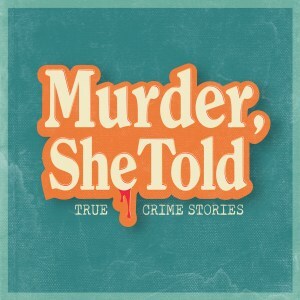 I covered this case on Murder, She Told in May of 2021, bringing Elizabeth’s story to a modern world. There were no hits for her name on the internet prior. Her case had been buried with time. Since releasing, I have heard from a few family members; among them, the great-granddaughter of Elizabeth, and a son of Robert Freel from his marriage after Elizabeth’s death.
I covered this case on Murder, She Told in May of 2021, bringing Elizabeth’s story to a modern world. There were no hits for her name on the internet prior. Her case had been buried with time. Since releasing, I have heard from a few family members; among them, the great-granddaughter of Elizabeth, and a son of Robert Freel from his marriage after Elizabeth’s death.
Her story is tragic, and puzzling. But it shouldn’t be forgotten.
The most frustrating part about this story is that I truly have no idea what I think happened to Elizabeth. Though I can entertain the two official theories, at the same time, neither of them makes sense to me. I don’t know how to wrap my head around at this case, and I think that’s why I find it so fascinating.
Even if we don’t have the answers, I hope that by sharing Elizabeth’s story, that a part of local history has been recovered and preserved. Her memory, once forgotten by the public, will continue to live on. Maybe that’s the only kind of justice we can offer.
For an extensive list of sources and to learn more about this case, visit https://www.murdershetold.com/episodes/elizabeth-freel.
Kristen Seavey is a victim’s advocate and the creator and host of Murder, She Told, an award-winning true-crime podcast that dives into the lesser-known cold cases and crime stories from Maine and New England. She is from Newport, ME.
You can find and listen to Murder, She Told free on any podcast platform, or at https://murdershetold.com
January 26, 2023
Real People in Fictional Stories
Charlene D’Avanzo: Reading Rhys Bowen’s latest “Royal Spyness” mystery (Peril In Paris) I was intrigued by the appearance of a historical person – Wallis Simpson – who reminds French police that she (Simpson) is the king of England’s fiancée and thereby rescues lead character Lady Georgina from a stint in jail.
Simpson, a storybook figure, is an intriguing addition to Bowen’s novel.

Wallis Simpson, Duchess of Windsor, was an American socialite and wife of the former King Edward VIII. Their intention to marry and her status as a divorcée caused a constitutional crisis that led to Edward’s abdication. Edward renounced the British throne on December 10, 1936 in order to marry Simpson.
The bottom line advice I’ve read about parody is don’t go half-way. Make sure the work is clearly parody so that you can argue no one would reasonably assume it is true. In parody the style of an author or work is closely imitated for comic effect or in ridicule.
In other words, if you decide to use a real historical figure or person in your novel you have to do it well.
Parody imitates noticeable features of an existing work in a comical way. Parodies comment on or make fun of the original and generally aim to amuse. They strictly deal with just one subject at a time and tend to be less serious in nature. Parody usually is for the purpose entertainment and amusement, while satire can lead to intense social/political critiques.
The use of parody includes using imitation or emphasis that draws attention to specific people, events, features, plots, etc. that are strange or silly in nature in order to add or develop humor.
Finally, you can use real historical figures to give historical context/texture to the story but they are not typically protagonists or other main characters.
January 24, 2023
Taking Joe Burgess to Miami
Kate Flora: I often preach, and yeah, I can get a bit preachy about things, that it is important for writers to get away from their desks, out into the world, and take some time to be observant. What’s around you? Who is around you? What are the colors, the sights, the sounds that are there? Sometimes the question is how you might use them in a book. Sometimes the question is how would your character see what you are seeing and how is it different from what you, the writer, are seeing?
important for writers to get away from their desks, out into the world, and take some time to be observant. What’s around you? Who is around you? What are the colors, the sights, the sounds that are there? Sometimes the question is how you might use them in a book. Sometimes the question is how would your character see what you are seeing and how is it different from what you, the writer, are seeing?
In the winter, I tend to hibernate. Close down the little ocean-front cottage, go home, put the gardens to bed, and sit in my office. I’m happy this way. I like to write. I like to read. I like to cook. Sometimes when the writing is slow, I sneak away to ebay and think about buying a fun new pair of shoes.
 But once in a while, we take an actual vacation, which is what we did last week. This actual vacation was to the Florida keys and then Miami Beach. Not very comfortable places for a desk-bound New Englander. After all, I was probably past forty before I allowed myself to wear something sleeveless and I still rarely wear shorts. But there I was, swathed in a large white garment to protect my easily burned skin, looking around. Listening. Trying to imagine how Joe Burgess might have felt and how he would have described what I was seeing.
But once in a while, we take an actual vacation, which is what we did last week. This actual vacation was to the Florida keys and then Miami Beach. Not very comfortable places for a desk-bound New Englander. After all, I was probably past forty before I allowed myself to wear something sleeveless and I still rarely wear shorts. But there I was, swathed in a large white garment to protect my easily burned skin, looking around. Listening. Trying to imagine how Joe Burgess might have felt and how he would have described what I was seeing.
In truth, on the beach in Miami, it was hard to figure out what Burgess would think of the nearly endless parade of women in thong bikinis. As his creator, I’m betting that his first thought would be how ridiculously uncomfortable they looked. His second, that people in Miami, like those on the streets of Portland, often exercise poor judgment in their choice of clothing as well as their behavior. Perhaps, though, once he’d gotten judgment out of his system, he might have settled in to enjoy the view.
Or would he? Would the strong odor of marijuana on the breeze be disconcerting to 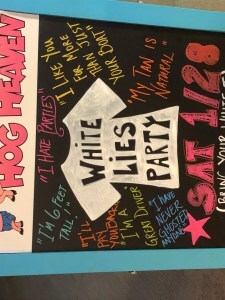 someone when during his entire career it had been illegal? What about the guys cruising the beach with cameras, chatting up awfully young girls and wanting to take their pictures? Would he keep a close eye on the vendors selling beer? The older guy plying young girls he’d met with drinks? Or would he just kick back, close his eyes, and bask in the sun?
someone when during his entire career it had been illegal? What about the guys cruising the beach with cameras, chatting up awfully young girls and wanting to take their pictures? Would he keep a close eye on the vendors selling beer? The older guy plying young girls he’d met with drinks? Or would he just kick back, close his eyes, and bask in the sun?
The you can take a cop out of New England, but you can’t stop him being a cop.
As we took a golf cart tour of about 50 blocks of buildings that were decorated with wall art, would he have been comfortable enjoying the talent of artists from all over the world allowed, or even paid, to do spray paint art on the sides of buildings? Would he have had a stronger reaction than I did to amazing works that had been tagged by vandals? Would he have been able to relax at all and enjoy it?
I think he would have allowed himself to relax and enjoy the night on a sunset cruise when the boat was suddenly surrounded by ten to fifteen dolphins. Out on the water, there were no bad guys to watch, few other boats posing a threat, and the nature and the sunset were spectacular.
He might have enjoyed the stunning visuals of SuperBlue Miami. He is, after all, a visual guy. Seeing beyond the ordinary is his job. Burgess is a guy who notices things–the things that are there and the things that aren’t. The small movements that people make that become tells that they are lying. The misbuttoned shirt or the small stain on a shoe. Being in a room that played to the senses might have been a great experience for him. His mind might wander, though, to people watching.
guy. Seeing beyond the ordinary is his job. Burgess is a guy who notices things–the things that are there and the things that aren’t. The small movements that people make that become tells that they are lying. The misbuttoned shirt or the small stain on a shoe. Being in a room that played to the senses might have been a great experience for him. His mind might wander, though, to people watching.
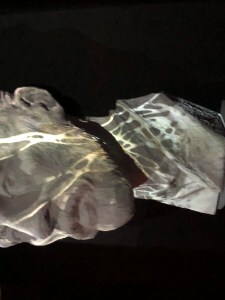 Or perhaps, like me, he’d enjoy an immersive show about Van Gogh. I’ve never thought about whether he’s an art fan. He lived a pretty monkish existence before he met Chris. But one thing he always did was take a picture of the crime scene after the body was gone, to remind himself of the void he needed to fill by solving the crime. Would seeing the sketches and then the finished works Van Gogh made make him think about process? Or about the choices that the creators had to make in order to put the show together. They were constructing a story. He is always reconstructing a story.
Or perhaps, like me, he’d enjoy an immersive show about Van Gogh. I’ve never thought about whether he’s an art fan. He lived a pretty monkish existence before he met Chris. But one thing he always did was take a picture of the crime scene after the body was gone, to remind himself of the void he needed to fill by solving the crime. Would seeing the sketches and then the finished works Van Gogh made make him think about process? Or about the choices that the creators had to make in order to put the show together. They were constructing a story. He is always reconstructing a story.
It’s probably a fact of a writer’s life. We may go away, but often our characters come with us, poking us from time to time to remind us to think about them.
Anyway, I had a great vacation in Florida even when I was dragged out of my comfort zone, and I had a lot of fun imagining Burgess along for the ride.


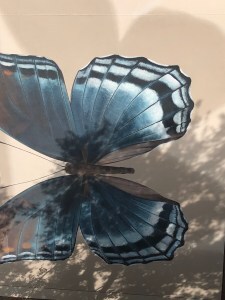

January 23, 2023
Bringing Characters to Life by Matt Cost
Should characters in books have political leanings? I mean, most people do. Some people claim that they hate politics, politicians, and never vote because they’re all crooks. But that is a political belief as well. Most of the rest of the population are just as adamant in their beliefs, be it left, right, or somewhere in the middle.
I understand that you don’t want to alienate a segment of the population. But the same can be said for just about any belief that a person has. Religion. Football fan. Soccer fan. Support Immigrants. Oppose Immigrants. Eat meat. Vegan. The list goes on and on.

It is my belief that creating a character in a book is like taking a store mannequin and bringing it to life. To do so, you have to provide a hairstyle, clothing, and mannerisms But this is still merely scratching the surface. If you want to truly bring this mannequin to life, you have to go deeper and reach the core essence.

What is the backstory of my protagonist? Sure, Clay Wolfe has commitment issues. But why? The writer has to know this, and share it with the reader, sometimes subtly, sometimes bluntly. His parents died in a car crash when he was eight, is the short version, and the longer version continues to leak out over the course of four books now, with a fifth due in December.
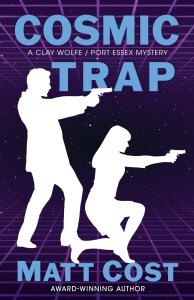
Goff Langdon in my Mainely Mystery series votes Independent, sometimes Democrat, and never Republican. Is that wrong? I welcome discourse, of course, on whether his political beliefs are right or wrong. The argument can certainly be made that Republican beliefs are more valid than that of Independents or Democrats. The question is: Is it wrong for him to have an opinion?
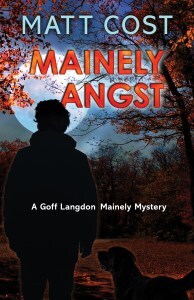
There seem to be two major rules of thumb of what not to do in a book. Don’t kill a pet, especially a dog or cat, and don’t allow your protagonist to have a political belief system. I am good with the first but question the second.
When a writer starts writing to not offend, then the creative process has been stymied. I don’t think we should use fiction to get on a high horse and use our novels as a podium to preach our politics, but to omit something as major as political leanings from our characters seems to be taking a step back to become an inanimate and thoughtless mannequin.
Enough of what I think. What do you all think? Should the protagonist of a book have a political belief system?

Matt Cost was a history major at Trinity College. He owned a mystery bookstore, a video store, and a gym, before serving a ten-year sentence as a junior high school teacher. In 2014 he was released and began writing. And that’s what he does. He writes histories and mysteries.
Cost has published four books in the Mainely Mystery series, with the fifth, Mainely Wicked, due out in August of 2023. He has also published four books in the Clay Wolfe Trap series, with the fifth, Pirate Trap, due out in December of 2023.
For historical novels, Cost has published At Every Hazard and its sequel, Love in a Time of Hate, as well as I am Cuba. In April of 2023, Cost will combine his love of histories and mysteries into a historical PI mystery set in 1923 Brooklyn, Velma Gone Awry.
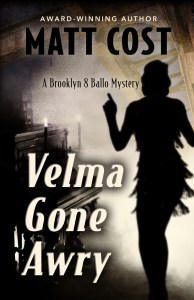
Cost now lives in Brunswick, Maine, with his wife, Harper. There are four grown children: Brittany, Pearson, Miranda, and Ryan. A chocolate Lab and a basset hound round out the mix. He now spends his days at the computer, writing.
Lea Wait's Blog
- Lea Wait's profile
- 509 followers



